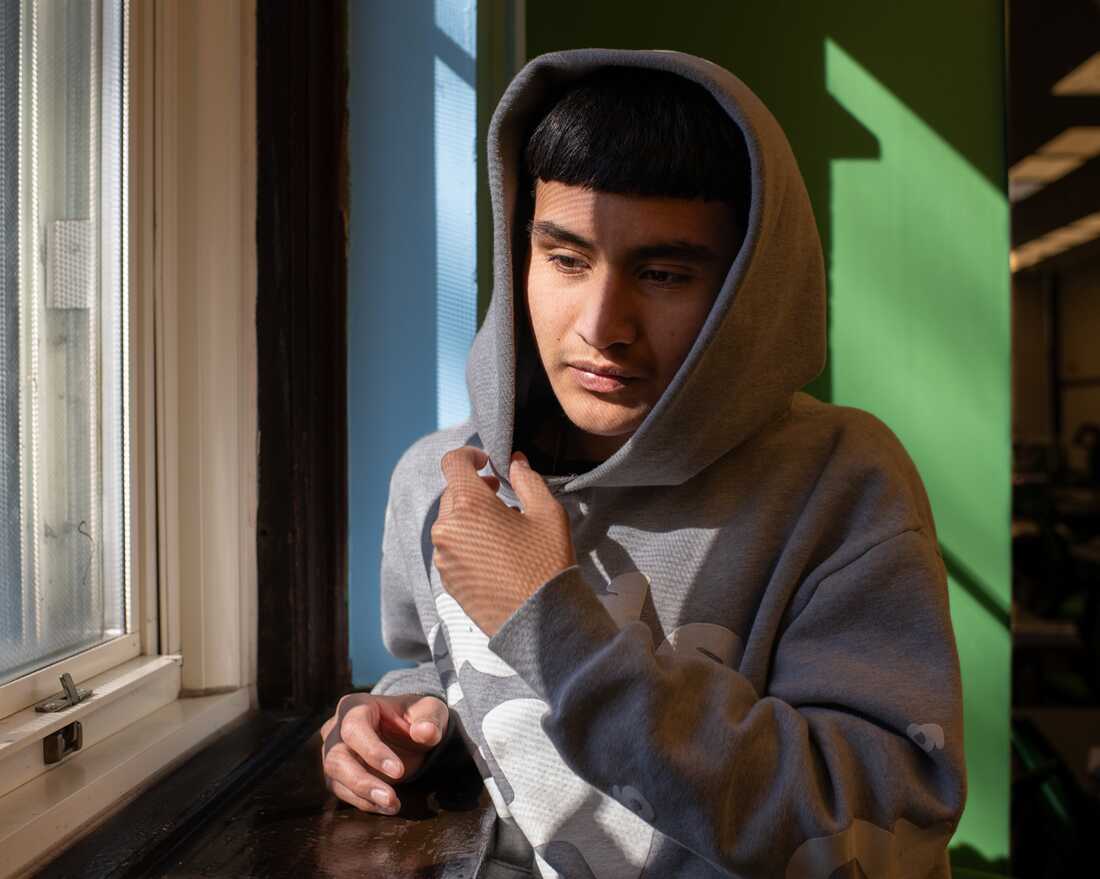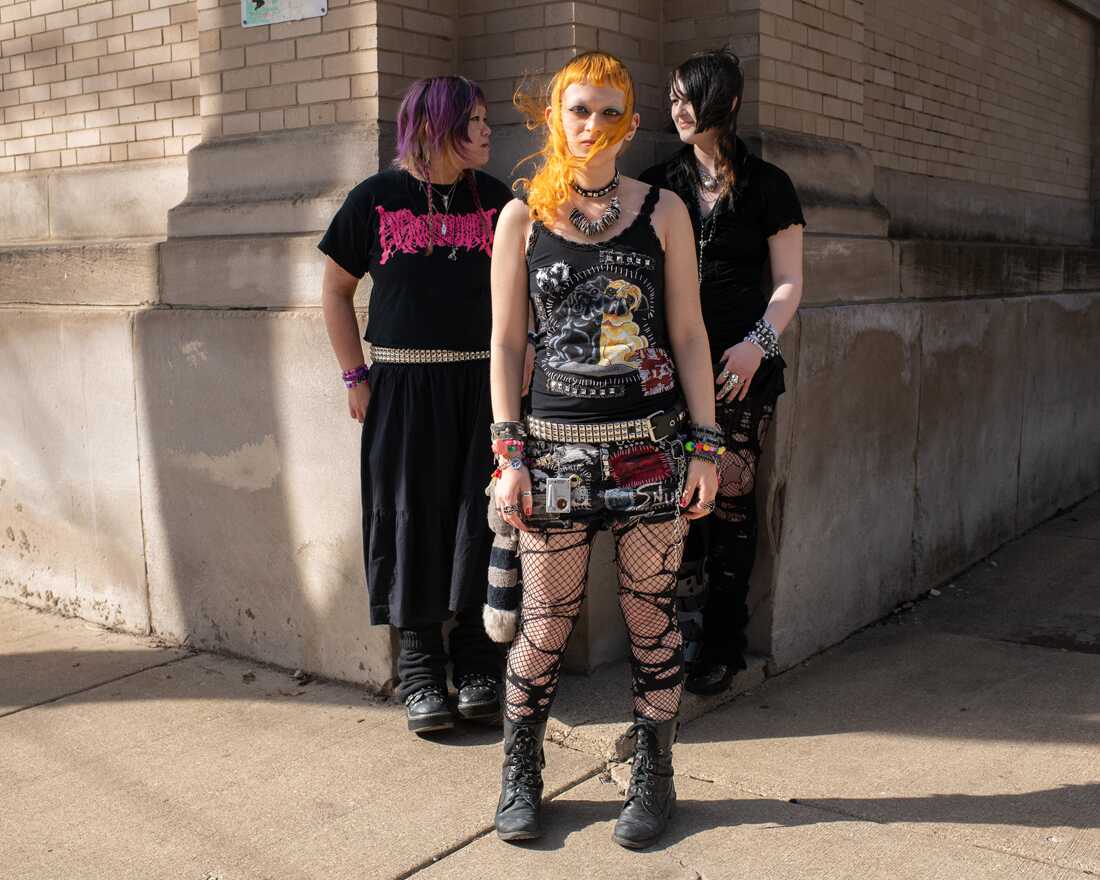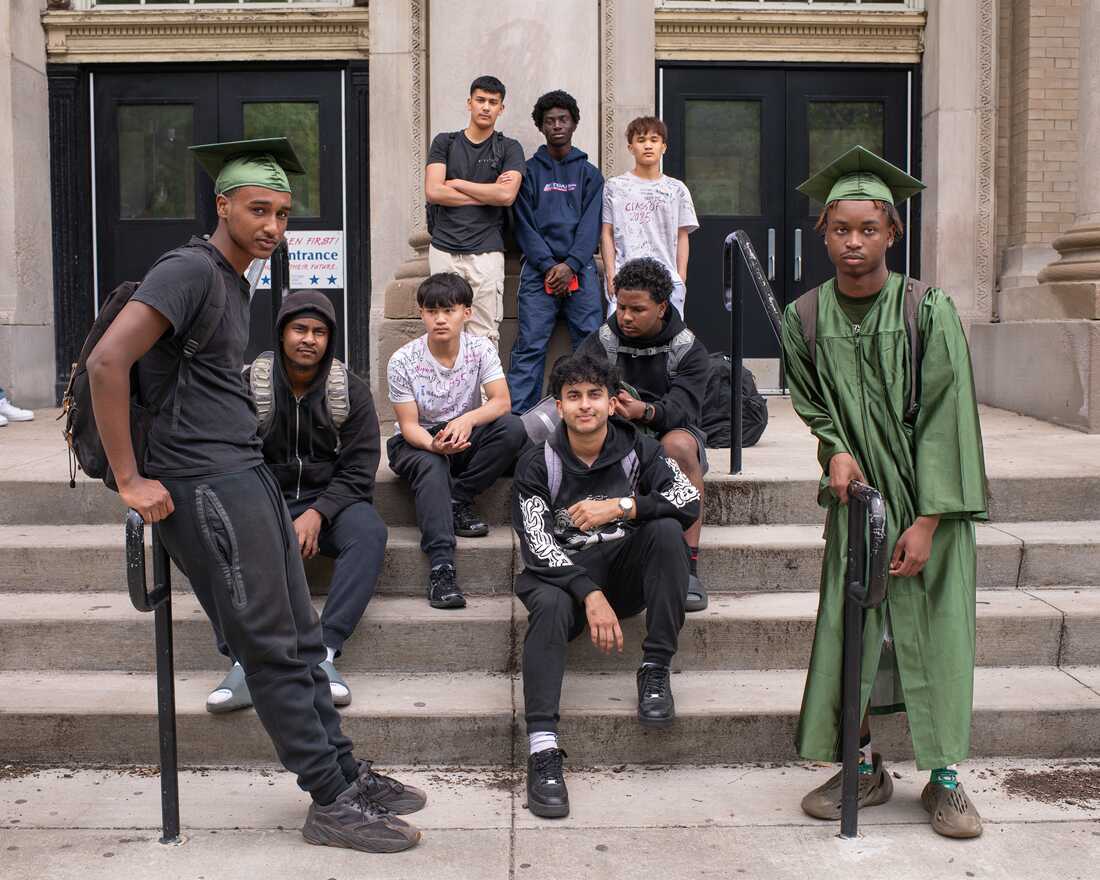News
A photographer captures life inside Chicago Public Schools

Jael Augustin, Ogden International High School, 2019.
Melissa Ann Pinney
hide caption
toggle caption
Melissa Ann Pinney
Melissa Ann Pinney photographed the everyday moments of adolescence inside Chicago Public Schools during a seven-year artist residency. Her series Becoming Themselves portrays students, especially those marginalized and underrepresented, as they navigate identity, community and the many transformations of growing up.
We interviewed Pinney about the making of her series and the stories behind some of her favorite images. The interview has been edited for clarity and length.

Mila Cardenas and Alvin Truong, Senn High School, 2023.
Melissa Ann Pinney
hide caption
toggle caption
Melissa Ann Pinney

Antonio Epps and his walking stick, Senn High School, 2025.
Melissa Ann Pinney
hide caption
toggle caption
Melissa Ann Pinney
What drew you to photograph inside Chicago Public Schools?
I was invited by Artists in Public Schools, an organization that pairs artists for residencies in schools all over the city, to photograph Bell School and Ogden International Schools. It was an incredible opportunity to photograph and immerse myself in often overlooked communities of children and teens in Chicago.
Since I was in my teens and photographing my own family, childhood and adolescence has been a focus of my work. Girl Ascending, my 2010 monograph, explored the social lives and coming-of-age rituals of my daughter, Emma, her friends and teammates. The possibilities inherent in widening the scope of my work beyond these established personal connections was exciting.

Asmah Mohammad Zakaria and Arshia Tahir, Senn High School, 2025.
Melissa Ann Pinney
hide caption
toggle caption
Melissa Ann Pinney

Hireath Magee, a 2022 graduate of Ogden International High School, in Chicago, 2024.
Melissa Ann Pinney
hide caption
toggle caption
Melissa Ann Pinney
When you first started, what kinds of images or stories did you hope to capture?
I’m interested in photography as a process, one of paying close attention to the richness and mystery already present in the everyday world. I capture what’s happening in the moment, and the story reveals itself afterwards in contemplation of the work itself.
This is an opportunity to make what I think of as real pictures — images that reward sustained and repeated viewings and eschew stereotype and cliché. I had no idea what to expect in the schools, but through trial and error, I found opportunities to make pictures as I became part of the school community. I never know what the students will do next — their beauty, their compassion and their conflicts are unrehearsed. The teens collaborate in the art-making by welcoming me into their world.
My photographs are both documents of a time and place and works of art. References to contemporary culture, to history and to ideas of representation are all embedded in the pictures. When I began photographing students in three different Chicago public schools, I had no idea of what was to come — how the project would evolve and shift through an ongoing global pandemic, a renewed focus on systemic racial and gender inequities and rampant gun violence. Now it’s a document of a historic time.

Emilio Castelan, Senn High School, 2024.
Melissa Ann Pinney
hide caption
toggle caption
Melissa Ann Pinney

Kevin Cooper, Senn High School, 2023.
Melissa Ann Pinney
hide caption
toggle caption
Melissa Ann Pinney
How much time did you spend working on Becoming Themselves?
This project is ongoing and still evolving since 2018, when I started photographing in Bell School. In Their Own Light was the first book of my early pictures from an elementary, middle and several high schools. In Becoming Themselves, I focus solely on two high schools — Ogden International High School and Senn High School — between 2019 and 2025.

Halloween, Senn High School, 2023.
Melissa Ann Pinney
hide caption
toggle caption
Melissa Ann Pinney

Khadijatou Sohna and Alyanna Manibo, Senn High School, 2024.
Melissa Ann Pinney
hide caption
toggle caption
Melissa Ann Pinney
What was the most challenging part of this project?
It is very hard to witness the grief and ongoing trauma many students experience as part of their everyday lives, especially when we hear that a student in the community has been shot and killed. Tragically, eight students I photographed died that way. The trauma of gun violence reverberates everywhere.

A flag football team, Senn High School, 2024.
Melissa Ann Pinney
hide caption
toggle caption
Melissa Ann Pinney

Homecoming pep rally, Senn High School, 2022.
Melissa Ann Pinney
hide caption
toggle caption
Melissa Ann Pinney

Lizzie Williams, Senn High School, 2021.
Melissa Ann Pinney
hide caption
toggle caption
Melissa Ann Pinney
What’s the story behind one of your favorite photographs?
With her My Little Pony leggings and arms loaded with jewelry, Lizzie Williams clearly stood out in the hallway crowded with students at their lockers gathering their coats and bags. I introduced myself and asked if Lizzie wanted to make a portrait. We went to the old gym for its brilliant light and huge south-facing windows. In the midst of working out Lizzie’s pose and position, the boys basketball team starting running laps around the gym, casting shadows onto the wall where Lizzie stood. At first I was annoyed by this unexpected disruption, but I soon realized that, far from an unwelcome distraction, the shadows suggest another level of mystery and complexity. I’m grateful for serendipity!
The DePaul University Art Museum added this photograph and six others from the project to their permanent collection last spring. A class of Senn students, many of whom are represented in the photographs, took a field trip to the museum to see the works.

Jae Nguyen, Sal Vega and Audrey Harmon, Senn High School, 2025.
Melissa Ann Pinney
hide caption
toggle caption
Melissa Ann Pinney

Kho’vya Greenwood and her brother, Coby, at Kho’vya’s prom send-off celebration, Chicago, 2022.
Melissa Ann Pinney
hide caption
toggle caption
Melissa Ann Pinney
Were there any moments that surprised you during the process?
Many moments surprised me.
One day early last fall, a student I hadn’t met before asked me to take his picture. I was happy to do so and we found a place by the windows with some light. When I looked through my lens, I suddenly recognized Axle, a student I’d first met two years before, when he transferred to Senn. I had photographed him several other times. Axle had transformed himself radically with a new short hair cut and different style of dress.
I am always surprised and moved when a student tells me that the project made a positive impact on their life. Travion Williams, at Ogden International High School, said he was shy, self-conscious and unsure of himself when we made his portrait in 2019. Travion’s portrait was one of the 84 portraits installed on panels in the school’s front lobby in the summer of 2020. Classes would be completely online that fall, but outdoor sports were still allowed. When the cross country team started practicing, Travion discovered that his friends and teammates recognized and admired him. It changed the way he saw himself.
It’s rewarding when I’m told by a student that my work is important to them. As my ties to the community have deepened — I’ve come to understand the meaning this project holds for me and for the students themselves, who tell me they feel truly “seen” by participating in the project. The students have profoundly affected the ways I understand the lives of others; my relationships now transcend school to include family events, parties and baby showers. I couldn’t have predicted the strong connections I would develop with some of the students, who keep in touch even years after they’ve graduated.
When I brought Sophiat Agboola a print of her portrait, she told me it was inspiring. Surprised, I asked in what way it was inspiring and to whom — I couldn’t guess. Sophiat said she had occasionally been made fun of for wearing her natural hair; her portrait had given her the confidence to do so.
Of course, the pandemic surprised me. And the fact that a project I expected to last one year could still be challenging and rewarding after seven was a complete surprise, too.

Jo Gonda and Andrew McDermott at prom, Senn High School, 2024.
Melissa Ann Pinney
hide caption
toggle caption
Melissa Ann Pinney

Jakolbi Lard, at prom, Ogden International High School, 2019. Lard was shot and killed in Chicago in January 2022.
Melissa Ann Pinney
hide caption
toggle caption
Melissa Ann Pinney
Do you have any memorable anecdotes or encounters from your time in the schools ?
I photographed Jakolbi Lard only once, at prom in 2019, drawn by the broken heart he had shaved in to his hair. In January 2022, I learned that Jakolbi had been shot and killed. Jakolbi’s death and the passage of time bring a different perspective to the broken heart shaved into his scalp. Now I see the wings formed by the mirror frame behind Jakolbi’s back. Jakolbi’s mother, Patricia Lard, told me that rather than being heartbroken, he was the heart-breaker. She brought Jakolbi’s daughter, Jamyah, to an exhibition that included Jakolbi’s portrait in 2023. She believes that exhibiting Jakolbi’s portrait honors his life. Ms. Lard thanked me for “… seeing in her Sun (sic) what the world did not.”

Shamaiya Mitchell and Stephon Wright, Senn High School, 2023.
Melissa Ann Pinney
hide caption
toggle caption
Melissa Ann Pinney

The last day of school for the class of 2025, Senn High School, 2025.
Melissa Ann Pinney
hide caption
toggle caption
Melissa Ann Pinney
Has working in schools changed how you think about education or childhood?
The students have a lot more agency than kids in my generation or even my daughter’s generation did. These students are free to define themselves through their chosen teams and clubs, their dress, sexual orientation, pronouns and sometimes taking on a new name. There’s a freedom in the acceptance and allowance for difference I see and a closeness in the physical camaraderie between many of the students.
I started reading the news more closely when I began this project. CPS (Chicago Public Schools) and the CTU (the Chicago Teachers Union) are frequently in the headlines. It’s clear that Chicago’s past is linked to its present by a history of events affecting the city in housing, education, racial and gender equity and immigration. All of these issues flow through the permeable wall between the city and the public schools.

DeJa Rae Reaves, a 2022 graduate of Ogden International High School. Reaves was shot and killed in April 2023, her freshman year at North Carolina A&T.
Melissa Ann Pinney
hide caption
toggle caption
Melissa Ann Pinney
What do you hope viewers take away from seeing these images?
I hope these pictures encourage a deeper consideration and appreciation of the radiant young people in our public schools that goes far beyond the stereotypes. I intend these portraits to honor and commemorate those who are vulnerable and often underrepresented.
Melissa Ann Pinney is an artist based in Chicago. You can see more of her work on her website, MelissaAnnPinney.com, or on Instagram, at @melissa_ann_pinney.

News
U.S. launches strikes in Syria targeting Islamic State fighters after American deaths

President Donald Trump and Defense Secretary Pete Hegseth salute as carry teams move the transfer cases with the remains of Iowa National Guard soldiers Sgt. William Nathaniel Howard, 29, of Marshalltown, Iowa, and Sgt. Edgar Brian Torres-Tovar, 25, of Des Moines, Iowa, and civilian interpreter Ayad Mansoor Sakat, who were killed in an attack in Syria, during a casualty return, Wednesday, Dec. 17, 2025 at Dover Air Force Base, Del.
Julia Demaree Nikhinson/AP
hide caption
toggle caption
Julia Demaree Nikhinson/AP
WASHINGTON — The Trump administration launched military strikes Friday in Syria to “eliminate” Islamic State group fighters and weapons sites in retaliation for an ambush attack that killed two U.S. troops and an American civilian interpreter almost a week ago.

A U.S. official described it as “a large-scale” strike that hit 70 targets in areas across central Syria that had IS infrastructure and weapons. Another U.S. official, who also spoke on condition of anonymity to discuss sensitive operations, said more strikes should be expected.
“This is not the beginning of a war — it is a declaration of vengeance. The United States of America, under President Trump’s leadership, will never hesitate and never relent to defend our people,” Defense Secretary Pete Hegseth said on social media.
The new military operation in Syria comes even as the Trump administration has said it’s looking to focus closer to home in the Western Hemisphere, building up an armada in the Caribbean Sea as it targets alleged drug-smuggling boats and vowing to keep seizing sanctioned oil tankers as part of a pressure campaign on Venezuela’s leader. The U.S. has shifted significant resources away from the Middle East to further those goals: Its most advanced aircraft carrier arrived in South American waters last month from the Mediterranean Sea.

Trump vowed retaliation
President Donald Trump pledged “very serious retaliation” after the shooting in the Syrian desert, for which he blamed IS. Those killed were among hundreds of U.S. troops deployed in eastern Syria as part of a coalition fighting the militant group.
During a speech in North Carolina on Friday evening, the president hailed the operation as a “massive strike” that took out the “ISIS thugs in Syria who were trying to regroup.”
Earlier, in his social media post, he reiterated his backing for Syrian President Ahmad al-Sharaa, who Trump said was “fully in support” of the U.S. effort.
Trump also offered an all-caps threat, warning IS against attacking American personnel again.
“All terrorists who are evil enough to attack Americans are hereby warned — YOU WILL BE HIT HARDER THAN YOU HAVE EVER BEEN HIT BEFORE IF YOU, IN ANY WAY, ATTACK OR THREATEN THE U.S.A.,” the president added.
The attack was conducted using F-15 Eagle jets, A-10 Thunderbolt ground attack aircraft and AH-64 Apache helicopters, the U.S. officials said. F-16 fighter jets from Jordan and HIMARS rocket artillery also were used, one official added.
U.S. Central Command, which oversees the region, said in a social media post that American jets, helicopters and artillery employed more than 100 precision munitions on Syrian targets.
How Syria has responded
The attack was a major test for the warming ties between the United States and Syria since the ouster of autocratic leader Bashar Assad a year ago. Trump has stressed that Syria was fighting alongside U.S. troops and said al-Sharaa was “extremely angry and disturbed by this attack,” which came as the U.S. military is expanding its cooperation with Syrian security forces.

Syria’s foreign ministry in a statement on X following the launch of U.S. strikes said that last week’s attack “underscores the urgent necessity of strengthening international cooperation to combat terrorism in all its forms” and that Syria is committed “to fighting ISIS and ensuring that it has no safe havens on Syrian territory and will continue to intensify military operations against it wherever it poses a threat.”
Syrian state television reported that the U.S. strikes hit targets in rural areas of Deir ez-Zor and Raqqa provinces and in the Jabal al-Amour area near the historic city of Palmyra. It said they targeted “weapons storage sites and headquarters used by ISIS as launching points for its operations in the region.”
IS has not said it carried out the attack on the U.S. service members, but the group has claimed responsibility for two attacks on Syrian security forces since, one of which killed four Syrian soldiers in Idlib province. The group in its statements described al-Sharaa’s government and army as “apostates.” While al-Sharaa once led a group affiliated with al-Qaida, he has had a long-running enmity with IS.
The Americans who were killed
Trump this week met privately with the families of the slain Americans at Dover Air Force Base in Delaware before he joined top military officials and other dignitaries on the tarmac for the dignified transfer, a solemn and largely silent ritual honoring U.S. service members killed in action.
The guardsmen killed in Syria last Saturday were Sgt. Edgar Brian Torres-Tovar, 25, of Des Moines, and Sgt. William Nathaniel Howard, 29, of Marshalltown. Ayad Mansoor Sakat, of Macomb, Michigan, a U.S. civilian working as an interpreter, also was killed.
The shooting near Palmyra also wounded three other U.S. troops as well as members of Syria’s security forces, and the gunman was killed. The assailant had joined Syria’s internal security forces as a base security guard two months ago and recently was reassigned because of suspicions that he might be affiliated with IS, Interior Ministry spokesperson Nour al-Din al-Baba has said.
The man stormed a meeting between U.S. and Syrian security officials who were having lunch together and opened fire after clashing with Syrian guards.
News
Trump’s push to end transgender care for young people opposed by pediatricians

A display at the Gender Health Program of Children’s Minnesota hospital. Under a proposed rule announced Thursday, a hospital will lose all its Medicaid and Medicare funding if it continues to provide gender-affirming care for trans people under age 18.
Selena Simmons-Duffin/NPR
hide caption
toggle caption
Selena Simmons-Duffin/NPR
Dr. Kade Goepferd watched the Trump administration’s moves on Thursday to ban gender-affirming care for transgender youth with “a mix of sadness and frustration.”
Goepferd, who is the founder of Children’s Minnesota Gender Health Program, says that for the medical community, nothing has changed about the evidence supporting gender-affirming care that could justify the government’s actions.

“There’s a massive propaganda and disinformation campaign that is selectively targeting this small population of already vulnerable kids and their families,” Goepferd says.
“Men are men”
Federal health officials said many times at Thursday’s announcement that their actions were driven by science and evidence, not politics or ideology. They frequently praised a report published by the Department of Health and Human Services in November. It concluded that clinicians who provide medical care to help youth transition have failed their patients and emphasized the benefits of psychotherapy as an alternative.
At times, health officials cast doubt on the idea that a person could be transgender at all.
“Men are men. Men can never become women. Women are women. Women can never become men,” said Acting CDC Director Jim O’Neill. He added that “the blurring of the lines between sexes” represented a “hatred for nature as God designed it.”
Health Secretary Robert F. Kennedy Jr. said doctors and medical groups had “peddled the lie” that these treatments could be good for children, and that those youth were “conditioned to believe that sex can be changed.”
Doctor groups disagree
The American Academy of Pediatrics, the medical group that represents 67,000 pediatricians across the country, pushed back forcefully on those characterizations.
“These policies and proposals misconstrue the current medical consensus and fail to reflect the realities of pediatric care and the needs of children and families,” said AAP President Dr. Susan J. Kressly in a statement. “These rules help no one, do nothing to address health care costs, and unfairly stigmatize a population of young people.”
AAP’s official position on this medical care is that it is safe and effective for the young people who need it. That view is shared by the American Medical Association, the Endocrine Society, among other medical organizations.
In a statement Thursday, the American Psychological Association wrote: “APA is deeply concerned about recent federal actions that not only challenge the scientific understanding of gender identity but also potentially jeopardize the human rights, psychological health, and well-being of transgender and nonbinary individuals.”
The most significant proposal released by HHS would withhold all Medicare and Medicaid funding from hospitals — a big portion of their budgets — if they provided gender-affirming care to those under age 18.
The Children’s Hospital Association said that rule — if finalized — would set a dangerous precedent. “Today’s proposed conditions make it possible for all kinds of specialized health care treatments to be withheld based on government-mandated rules,” wrote CEO Matthew Cook. “Millions of families could lose access to the care they need.”
After a 60-day comment period, the rules could be finalized and then take effect.
Attorneys general in New York and California have said they will fight these rules and protect the rights of trans people to get care in their states. The ACLU has vowed to sue, and more legal challenges are expected.
“I don’t want to be lost”
According to a CDC survey, about 3% of teenagers aged 13-17 identify as transgender, approximately 700,000 people. A poll from health research organization KFF found that less than a third of transgender people took medication related to their identity and 16% had had surgery.
For young people, medical options most commonly include puberty blockers and hormones. Surgery is very rare for minors. “This is health care that evolves over time, is individualized, tailored to a patient’s needs, often after years of relationship with a trusted health care team,” says Goepferd.
NPR spoke to a transgender 15-year old in California this week about the moves Trump administration officials were making to restrict care. “They think what I’m feeling is a phase and that my family should just wait it out and that it’s better I’m unhappy and never receive care,” he says. NPR agreed not to name him because of fears for his safety.
He says it can be difficult for those who are not transgender to understand that experience, but that, as far as he can tell, these health officials “are not interested in understanding trans people.”
He describes the long and deliberate process he made with his parents and doctors before he began taking testosterone. “The decision to not start gender-affirming care is often just as permanent as a decision to start it,” he says. “Not starting [hormone therapy], for some people, it feels like ruining our body, because there are certain changes we can never have.”
Now, after six months on testosterone, he feels like he’s on the right path, and is worried about the prospect of losing access to his medication if HHS’s efforts to shut down care nationally succeed. “It feels like someone’s throwing me into the bush just off the path I’m on, and that’s kind of terrifying,” he says. “I don’t want to be lost. I want to keep going where I’m going.”
“Deep moral distress”
More than half of states already ban gender-affirming care for young people after a frenzy of laws passed since 2021 in Republican-led states. This week, Republicans in the House led efforts to pass two federal bills that would restrict access to care, including one that could put doctors who provide the care in prison for up to ten years. It’s unclear if the bills will be voted on in the Senate.
Although nothing has officially changed in states where the care is still legal, these efforts to enact national restrictions have doctors and health systems in those states bracing for the possibility that their clinics will have to close down.

Dr. Kade Goepferd takes care of transgender and gender diverse young people at Children’s Minnesota hospital.
hide caption
toggle caption
“There’s a deep moral distress when you know that there is care that you can provide to young people that will measurably improve their health and the quality of their life, and you’re being restricted from doing that,” Goepferd of Children’s Minnesota says. “And there’s a moral distress in feeling like — as a hospital or a health care system — you have to restrict care that you’re providing to one population to remain financially viable to provide health care for other kids.”
News
Takeaways from an eventful 2025 election cycle

Is there such a thing as an “off year” for U.S. elections? The elections in 2025 were not nearly as all-encompassing as last year’s presidential race, nor as chaotic as what is expected from next year’s midterms. But hundreds of elections were held in dozens of states, including local contests, mayoral races, special congressional elections and two highly anticipated governor’s races.
Many of the elections were seen as early tests of how lasting President Trump’s 2024 gains might be and as a preview of what might happen in 2026.
Here are five takeaways from the 2025 election cycle.
In Elections Seen as Referendums on Trump, Democrats Won Big
Democrats did well in nearly all of this year’s elections, continuing a pattern that has played out across off-year elections for the last two decades: The party that wins the White House routinely loses ground in the next round of elections.
The change in the final margin from the presidential election to the next election for governor
Virginia and New Jersey have historically swung away from the president’s party in governor’s races
Elections in these years are often viewed as referendums on the president’s performance. And Mr. Trump’s approval ratings, after months of holding steady, took a dip in November.
A notable shift came in New Jersey, where the majority-Hispanic townships that swung toward Mr. Trump in 2024 swung back to Democrats in the 2025 governor’s race. That contributed significantly to the victory of Representative Mikie Sherrill, the Democratic candidate, over Jack Ciattarelli, the Trump-backed Republican.
New Jersey’s majority-Hispanic towns snapped back left in 2025
Each line is a township whose width is sized to the number of votes cast in 2025
The leftward swing was viewed by many political commentators as a reaction to Mr. Trump. If that is the case, it remains to be seen how much of it will carry over into 2026.
Progressive and Moderate Democrats Are Both Claiming Victories
Democratic strategists continue to debate whether the party should embrace progressive candidates or more moderate ones. And in 2025, the election results had both sides feeling emboldened.
In New York City, Zohran Mamdani, a democratic socialist who struggled to garner support from the Democratic Party, defeated former Gov. Andrew Cuomo by nine points. A similar story played out in Jersey City, where James Solomon, a progressive, crushed former Gov. James McGreevey of New Jersey in a mayoral runoff. Progressives also prevailed in cities like Detroit and Seattle.
Centrist Democrats, meanwhile, came away with arguably the two biggest wins of the year against Trump-endorsed Republicans. Abigail Spanberger and Ms. Sherrill, both Democrats, outperformed their polling estimates and decisively won the high-profile governor’s races in Virginia and New Jersey.
The debate will continue among Democrats as several 2026 primaries have prominent progressive and moderate candidates going head to head.
In Texas, Representative Jasmine Crockett, a progressive, entered the primary race for a U.S. Senate seat against the more moderate James Talarico. A similar situation has developed in Maine, where Graham Platner has pitched himself as a more progressive alternative to Janet Mills in the party’s attempt to unseat Senator Susan Collins, a Republican. Other progressives, like Julie Gonzales in Colorado and Brad Lander in New York, are challenging incumbent Democrats in primary races.
A Record 14 Women Will Serve as Governors in 2026
Virginians elected Ms. Spanberger as their first female governor. In New Jersey, Ms. Sherrill became the second woman to secure the position. Both women significantly outperformed Vice President Kamala Harris’s margins from the 2024 presidential race, improving on her results by almost 10 points.
Female candidates also did well down the ballot. Eileen Higgins will be the first female mayor in Miami after defeating Emilio González, who had the support of Mr. Trump. And, in Seattle, Katie Wilson defeated the incumbent mayor, Bruce Harrell.
States that will have female governors in 2026
Come 2026, a record 14 women — 10 Democrats and four Republicans — will serve as governors, with six of them expected to run for re-election next year. (More than a dozen states have yet to elect a female governor.)
In New York, it is likely that both candidates will be women: Representative Elise Stefanik, a Republican, began a campaign last month against the incumbent, Kathy Hochul.
Special Elections Are Still Very Special (for Democrats)
Despite not flipping any House seats, Democrats outperformed Ms. Harris’s 2024 results in every House special election this cycle. Their wins, however, offer limited insight into what might happen in 2026.
Special elections, which happen outside of regular election cycles to fill vacated seats, draw fewer voters than those in midterm or presidential years. Special election voters tend to be older and highly engaged politically, and they are more likely to be college educated. That has given Democrats a distinct advantage in recent years, and 2025 was no exception.
Democratic candidates in this year’s special congressional elections outperformed Kamala Harris’s 2024 margins.
Democrats did well in the 2025 special elections
Democratic strength in special elections extended to lower-profile races held this year. In Virginia, Democrats secured 64 out of 100 seats in the House of Delegates. In Georgia, Democrats won two seats on the Georgia Public Service Commission, the first time the party won a non-federal statewide office since 2006. Pennsylvania Democrats swept the major Bucks County contests, electing a Democratic district attorney for the first time. And, in Mississippi, Democrats broke the Republican supermajority in the State Senate.
Odd-Numbered Years Are Still Very Odd (for Election Polls)
Polling in off-year election cycles is challenging because it’s hard to know who will turn out to vote. This year, the polls significantly overestimated the Republicans in the Virginia and New Jersey governor’s races, which both had particularly high turnout for an off year. In 2021, polls had the opposite problem, as they overestimated Democrats.
Each dot is a poll from the relevant governor’s election, positioned according to its polling error in the election.
Polls missed in opposite directions in 2021 and 2025
Polling misses don’t necessarily carry over from cycle to cycle: Despite the leftward bias of the polls in 2021, they performed very well in 2022. After each election, pollsters look at the result and evaluate their performance, and then note where they went wrong. Analysis from groups like the American Association for Public Opinion Research frequently indicates that errors come from an incorrect sense of who shows up to vote. Pollsters then try to adjust for this error in the next election cycle.
The errors of 2025 may prove largely irrelevant, however, as the midterm elections will feature a larger, very different pool of voters with a new set of races, and a new host of lessons for pollsters to learn.
Off years are weird, and the polling errors they produce often are as well.
-

 Iowa5 days ago
Iowa5 days agoAddy Brown motivated to step up in Audi Crooks’ absence vs. UNI
-

 Iowa7 days ago
Iowa7 days agoHow much snow did Iowa get? See Iowa’s latest snowfall totals
-

 Maine4 days ago
Maine4 days agoElementary-aged student killed in school bus crash in southern Maine
-

 Maryland5 days ago
Maryland5 days agoFrigid temperatures to start the week in Maryland
-

 Technology1 week ago
Technology1 week agoThe Game Awards are losing their luster
-

 South Dakota6 days ago
South Dakota6 days agoNature: Snow in South Dakota
-

 New Mexico3 days ago
New Mexico3 days agoFamily clarifies why they believe missing New Mexico man is dead
-

 Nebraska1 week ago
Nebraska1 week agoNebraska lands commitment from DL Jayden Travers adding to early Top 5 recruiting class
















